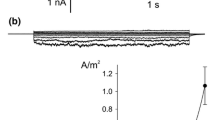Abstract.
In order to study the mechanism and regulation of K+ resorption from the xylem by the cells that border the xylem vessels (the xylem parenchyma cells), K+ inward-rectifying channels (KIRCs) in the plasma membrane of xylem parenchyma cells from Hordeum vulgare L. cv. Apex were studied using the patch-clamp technique. In the inside-out configuration, three different types of K+ channel and a further K+ conductance could be identified. Two of these channels, named KIRC1 and KIRC2, were activated by guanosine 5′-[β,γ-imido]triphosphate (Gpp(NH)p; 150 μM), a non-hydrolyzable derivative of GTP, indicating that channel activity was up-regulated by G-proteins; modulation of channel activity occurred via a membrane-delimited pathway, since the effect could be demonstrated in cell-free patches. At 100 mM external K+, KIRC1 had a conductance of 8 pS. There was no effect of ATP on channel activity. Likewise, addition of 150 μM guanosine 5′-[β-thio]diphosphate (GDPβS) or adenosine 5′-[γ-thio]triphosphate (ATPγS) failed to activate KIRC1, indicating nucleotide specificity of the effect. A second K+ channel, activated by Gpp(NH)p (KIRC2) with gating properties clearly different from the first one was less frequently observed. Four different substates could be identified; the main level had a conductance of about 2 pS. Gating below the Nernst potential of K+ (EK) was voltage-independent. The channel closed at potentials more positive than EK. A third, hyperpolarization-activated K+ channel, KIRC3, with a low open probability was encountered in inside-out patches. It had a conductance of 45 pS in 100 mM K+. Channel activity was not affected by the addition of G-protein modulators. Moreover, slowly activating inward currents carried by K+ were recorded in several patches that are ascribed to a `subpicosiemens conductance'. Neither GDPβS nor Gpp(NH)p appeared to have an effect on the currents. Whole-cell measurements with these G-protein modulators included in the pipette solution were in general agreement with the results obtained on cell-free patches. A statistical evaluation revealed that time-dependent inward currents were larger when the G-protein activator Gpp(NH)p was included in the pipette medium compared to measurements with the inhibitor GDPβS. With the GTP analogue, an additional instantaneous component was elicited that was ascribed to KIRC2 activity. Data are discussed with respect to the putative role of G-proteins in conveying hormonal signals. Regulation by G-protein may either serve to fine-tune K+ uptake by xylem parenchyma cells or to initiate depolarization, followed by salt-efflux through depolarization-activated cation and anion channels.
Similar content being viewed by others
Author information
Authors and Affiliations
Additional information
Received 11 October 1996 / Accepted: 21 April 1997
Rights and permissions
About this article
Cite this article
Wegner, L., Boer, A. Two inward K+ channels in the xylem parenchyma cells of barley roots are regulated by G-protein modulators through a membrane-delimited pathway. Planta 203, 506–516 (1997). https://doi.org/10.1007/s004250050220
Issue Date:
DOI: https://doi.org/10.1007/s004250050220




